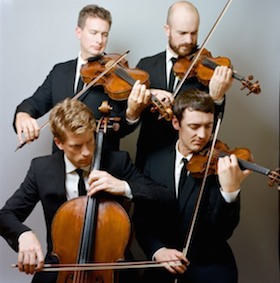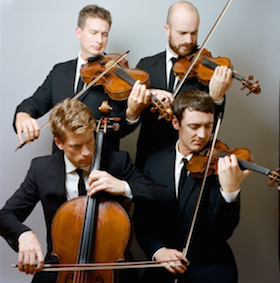
During the Great War, the composer Béla Bartók was surveying his Hungarian countryside and chronicling the peasant music he heard there. Over time, he worked aspects of this humble music into his elevated compositional style. The angular intervals, non-tonal melodies, rhythmic complexities, and non-triadic harmonies of the peasant tunes helped Bartók to write music that sounded simultaneously modern yet also rooted in Hungarian tradition. This quintessential synthesis characterizes his six string quartets, which he wrote over the course of 30 years. In other words, his quartets perpetuate a classical genre while consummately documenting not only the evolution of Bartók’s own composing, but also key trends in 20th-century composition more broadly.
It is unsurprising that the Calder Quartet would be drawn to these diverse and distinctive works. Founded in the late 90s at the University of Southern California, this award-winning ensemble is known both for its wide-ranging repertoire and for its support of contemporary music. On Sunday evening at SF JAZZ Center’s Miner Auditorium, the group played its second in a series of three concerts devoted to performing all six of Bartók’s quartets. His second and third were on Sunday’s program.
Rounding out the evening was Iva Bittová, a violinist and vocalist from the Czech Republic. She is also known for her dexterity across multiple types of music. She began the evening by playing and singing a solo work of her own, which may have been partially improvised. Several aforementioned musical characteristics —dissonance, angularity, and melodic-rhythmic intricacy — were impressively illustrated. She also began the second half by performing chamber works with members of the ensemble written by Janáček and other Czech composers.
Bartók wrote his second quartet during WWI. It is in three movements (slow-fast-slow) and technically challenging, especially the conclusion of the second movement, which is staggeringly fast. But Calder handled it seemingly without breaking a sweat.
The introspective third movement of this quartet meanders somewhere between melancholy and menacing. The group carefully passed around its opening sigh motif, which sounds desolate and resigned. Over time the movement builds into something perhaps more combative or emphatic; certainly, there are climatic in-unison moments. But then — like four people individually grappling with the same sad idea — the voices splinter off, and the fragments spread into a soundscape that is familiar from the movement’s opening. Its inconclusive, soft ending was a bold programming choice insofar as it marked a stark contrast to the resolute, triumphant finales that often precede intermissions.
Nearly a decade later (1926), Bartók conceived of his third quartet as a single continuous movement. Nonetheless, it does subsume clear subsections: at least on an abstract level, the work is in sonata form. Its second theme is faster than its first, and any given occurrence of the second idea sounds like a variation of a previous variation. Clocking in at a mere 15 minutes, this work is compact yet explosive, playing out like a pint-sized gymnast on an astonishing tumbling run.
I suspect that a piece as condensed or tightly woven as this one almost demands the intimacy of players who, like the members of Calder, have practiced together for years. So I was glad Calder was playing this particular work, and it was also wonderful to hear Bittová return to perform a few encore pieces with the quartet. All told, the blending of Bittová and Calder seemed an apt (perhaps even a deliberate) evocation of Bartók’s famous ability to fuse: Like his quartets, these performers expertly drew together folk and high art, western and eastern European identity, and especially respect for tradition with the pioneering spirit of modernism.

